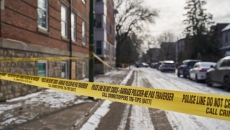Kay Matthews doesn't mince words when asked about the state of businesses fighting to survive in downtown cores across Ontario.
"We're struggling," said Matthews, executive director of the Ontario Business Improvement Area Association.
"We're seeing the impacts from one end to the province to the other … For the first time, Ottawa's even seeing economic impacts that they've never seen in past."
The experiences in Ontario's cities are echoed across Canada, as downtowns grapple with high vacancy rates, the post-pandemic work culture and the prospect that crowds of office workers may never return in full.
That could spur a shift in the fundamental nature of Canada's downtown neighbourhoods, but experts say such a major alteration will take time, requiring large investments and changes to infrastructure to bring people back.
Members of the International Downtown Association Canada gathered in November in Ottawa to urge the federal government to extend the deadline for businesses to repay emergency loans taken out during the pandemic.
But beyond loan relief, the group also wants direct federal funding for downtown business associations to bolster their neighbourhoods.
Downtown street-front business vacancy rates range from 11 to 14 per cent in cities such as Toronto, Montreal, Victoria and Halifax. Edmonton and Winnipeg have downtown vacancy rates has high as 33 per cent.
Association chair Kate Fenske, who is also CEO of the Downtown Winnipeg Business Improvement Zone, said weaker downtowns dent the country's overall economy and fiscal stability.
"If your city's downtown isn't strong, your city cannot be strong," Fenske said. "And so, when we look at, for example, Winnipeg, our downtown … makes up less than 1 per cent of the total land, but it generates 17 and 14 per cent of commercial tax and business tax. So, those funds are actually supporting services and amenities throughout the entire city."
Federal Tourism Minister Soraya Martinez Ferrada, whose portfolio also includes economic development for Quebec, said she has engaged with several representatives from downtowns in that region.
Martinez Ferrada said the federal government is looking to support downtown revitalization through several agencies, but there are also opportunities to rethink the core purpose of downtowns, creating new ways to bring people back without relying on office workers.
"One of the opportunities that we see is for those cities to develop kind of a new stream of how can we use downtown cores," she said.
"So, I think you will see a lot of transformations around what downtown will mean in the future. And yes, tourism it is a big part of that."
The school of cities at the University of Toronto conducts a "downtown recovery" project, charting the state of downtowns across North America.
The study compares the number of current unique visitors in a city's downtown with the same time period in 2019, just before the COVID-19 pandemic began.
As of October, visitors counts in Montreal were about 67 per cent of pre-pandemic levels, followed by Toronto at 70 per cent, Winnipeg at 76 per cent and London, Ont., at 79 per cent. Vancouver was at 85 per cent, while Mississauga, Ont., had the highest visitor count in Canada at 91 per cent.
University of Toronto school of cities director Karen Chapple said many downtowns were designed with an "overdependence" on office space, with transportation and urban design all catering to that economy.
Chapple said downtowns have undergone transitions in the past, such as the shift away from manufacturing in the early 1900s, but it could take decades for neighbourhoods to adjust to a new business model.
"You don't just change up your economy overnight," she said. "They're going to have to diversify again a little bit more, and that's a slow process that takes — if we're true to history — it's probably going to take a decade or more to restructure."
For Prairie cities, such as Edmonton and Winnipeg, one challenge will be attracting more residential development downtown, said Edmonton Downtown Business Association executive director Puneeta McBryan.
The problem is that downtown development is expensive but rents are low, she said.
McBryan said developers need governments to provide more incentives for such projects.
"I think we persisted through the pandemic on a lot of optimism … and we're at this point where I think the realization has started to settle in that where we are today is kind of this new normal.
"There are people living downtown and people who are still treating downtown like a destination for shopping and dining," she said. "But we can't rely on five-day-a-week office traffic, that we know."
A rise in vandalism and other crimes in some city cores is also putting a strain on businesses.
Tasha Morizio, general manager of La Société de développement du boulevard Saint-Laurent in Montreal, said businesses in her district reported three incidents of storefront glass being broken and stock being stolen in one week.
"That's just another hurdle that these small mom-and-pop shops are having to deal with," Morizio said. "And obviously, our hearts are open. We're not here trying to say that we don't want you on our commercial street. I think that we need more resources, and we need more leadership coming from the federal government."
Police statistics don't necessarily show crime levels are on the rise, however.
Vancouver Police's GeoDash Crime Statistics Hub, for instance, showed commercial break-and-enters in the central business district were down 26 per cent in an eight-week period this fall when compared with the same time last year.
Offences against people were down 12 per cent in the same period, although mischief and theft from vehicles rose slightly.
Toronto Police statistics comparing 2021 and 2022 showed increases in offences in some downtown areas but decreases in others, while Ottawa Police said the crime rate in Ward 14, where much of downtown is located, rose 7.3 per cent.
Ontario's Matthews said the data doesn't always reflect reality, and owners of one business told her recently they will close because they were "tired of having to replace" broken windows.
"So, it's not just happening once, but it's happening repeatedly," she said. "Downtown Hamilton has some beautiful, beautiful, busy properties (that) date back to the 1890s and the 1920s, and they're seeing even things like the door knobs being stolen."
Montreal's Morizio said the long-term solution may be to re-establish downtowns as a place for social connection rather than just going to an office.
She said Montreal has begun installing pedestrian-only streets to create public spaces, but such projects are costly and not applicable everywhere.
"People aren't going to come to work more than two or three days a week … So, I think to be able to counter that, what we need to do is we need our commercial streets to almost be our third place," she said, referring to a familiar public spot that people can go.
"Besides our dwelling and where we work, we need a space where people can come and connect. That's a lot of what we lost during the pandemic."






